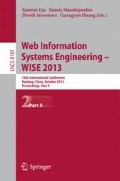Abstract
Communities’ identification in topic-focused social media users interaction networks can offer improved understanding of different opinions and interest expressed on a topic. In this paper we present a community detection approach for user interaction networks which exploits both their structural properties and intensity patterns. The proposed approach builds on existing graph clustering methods that identify both communities of nodes, as well as outliers. The importance of incorporating interactions’ intensity in the community detection algorithm is initially investigated by a benchmarking process on synthetic graphs. By applying the proposed approach on a topic-focused dataset of Twitter users’ interactions, we reveal communities with different features which are further analyzed to reveal and summarize the given topic’s impact on social media users.
Access this chapter
Tax calculation will be finalised at checkout
Purchases are for personal use only
Preview
Unable to display preview. Download preview PDF.
References
Ankerst, M., et al.: Optics: ordering points to identify the clustering structure. In: SIGMOD, pp. 49–60 (1999)
Arenas, A., et al.: Community analysis in social networks. European Physics Journal B 38(2), 373–380 (2004)
Blei, D.M., et al.: Latent Dirichlet allocation. Journal of Machine Learning Research 3(4-5), 993–1022 (2003)
Bortner, D., Han, J.: Progressive clustering of networks using structure-connected order of traversal. In: ICDE, pp. 653–656 (2010)
Danon, L., et al.: Comparing community structure identification. J. Stat. Mech. P09008(0505245) (2005)
Ester, M., et al.: A density-based algorithm for discovering clusters in large spatial databases with noise. In: KDD, pp. 226–231 (1996)
Girvan, M., Newman, M.E.J.: Community structure in social and biological networks. Proc. of the National Academy of Sciences USA 99(12) (2002)
Jurgens, D., Lu, T.-C.: Friends, Enemies, and Lovers: Detecting Communities in Networks Where Relationships Matter. In: WebScience (2012)
Kamath, K.Y., Caverle, J.: Transient crowd discovery on the real-time social web. In: WSDM, pp. 585–594 (2011)
Lancichinetti, A., Fortunato, S.: Benchmarks for testing community detection algorithms on directed and weighted graphs with overlapping communities. Phys. Rev. E 80(016118) (2009)
Lancichinetti, A., et al.: Finding statistically significant communities in networks. PLoS ONE 6, e18961 (2011)
Morrison, D., et al.: Evolutionary clustering and analysis of user behaviour in online forums. In: ICWSM, 519–522 (2012)
Newman, M.E.J.: Power laws, Pareto distributions and Zipf’s law. Contemporary Physics 46, 323–351 (2005)
Newman, M.E.J., Girvan, M.: Finding and evaluating community structure in networks. Phys. Rev. E 69 (2004)
Newman, M.E.J.: Finding community structure in networks using the eigenvectors of matrices. Phys. Rev. E 74(0602124v1) (2006)
Opsahl, T., Panzarasa, P.: Clustering in weighted networks. Social Networks 31(2), 155–163 (2009)
Papadopoulos, S., et al.: Community detection in social media. Data Mining & Knowledge Discovery 24, 515–554 (2012)
Sander, J., Qin, X., Lu, Z., Niu, N., Kovarsky, A.: Automatic extraction of clusters from hierarchical clustering representations. In: Whang, K.-Y., Jeon, J., Shim, K., Srivastava, J. (eds.) PAKDD 2003. LNCS (LNAI), vol. 2637, pp. 75–87. Springer, Heidelberg (2003)
Sun, J., et al.: Graphscope: parameter-free mining of large time-evolving graphs. In: KDD, pp. 687–696 (2007)
Sun, H., et al.: gskeletonclu: Density-based network clustering via structure-connected tree division or agglomeration. In: ICDM, pp. 481–490 (2010)
Ugander, J., et al.: The anatomy of the facebook social graph. CoRR abs/1111.4503 (2011)
Xu, X., et al.: Scan: a structural clustering algorithm for networks. In: KDD, pp. 824–833 (2007)
Author information
Authors and Affiliations
Editor information
Editors and Affiliations
Rights and permissions
Copyright information
© 2013 Springer-Verlag Berlin Heidelberg
About this paper
Cite this paper
Giatsoglou, M., Chatzakou, D., Vakali, A. (2013). Community Detection in Social Media by Leveraging Interactions and Intensities. In: Lin, X., Manolopoulos, Y., Srivastava, D., Huang, G. (eds) Web Information Systems Engineering – WISE 2013. WISE 2013. Lecture Notes in Computer Science, vol 8181. Springer, Berlin, Heidelberg. https://doi.org/10.1007/978-3-642-41154-0_5
Download citation
DOI: https://doi.org/10.1007/978-3-642-41154-0_5
Publisher Name: Springer, Berlin, Heidelberg
Print ISBN: 978-3-642-41153-3
Online ISBN: 978-3-642-41154-0
eBook Packages: Computer ScienceComputer Science (R0)

